In today’s digital age, our smartphones are more than just devices for communication; they are hubs of personal information, memories, and sensitive data. Losing a phone can be a distressing experience, not just because of the financial cost, but also due to the potential exposure of your private information. To protect yourself, it’s crucial to take proactive steps before anything happens. Here’s a comprehensive guide to securing your phone and data before you lose your device.
1. Enable a Strong Password or Biometric Lock
The first line of defense for your smartphone is a secure lock screen. Here’s how to ensure yours is as strong as possible:
- Use a Strong Password: Avoid simple PINs like “1234” or “0000.” Instead, opt for a complex password with a mix of letters, numbers, and symbols.
- Enable Biometric Security: Most modern smartphones offer biometric options like fingerprint scanning or facial recognition. These add an extra layer of security, making it harder for anyone else to access your device.
2. Set Up a Remote Tracking and Wiping Service
In case your phone goes missing, having a remote tracking and wiping service enabled can be a lifesaver. This allows you to locate your phone, lock it, or even erase all the data remotely. Here’s how to set it up:
- For Android Users:
- Go to “Settings” > “Security” > “Find My Device.”
- Ensure that the feature is enabled.
- Test it by logging into your Google account on another device and visiting the Find My Device page.
- For iPhone Users:
- Open “Settings” and tap on your name at the top.
- Select “Find My” > “Find My iPhone.”
- Toggle the switch to turn it on, and also enable “Send Last Location.”
With these features enabled, you can quickly locate your phone or secure it if it’s lost or stolen.
3. Backup Your Data Regularly
Losing your phone shouldn’t mean losing your data. Regular backups ensure that your photos, contacts, and important files are safe, even if your device is lost. Follow these steps to set up automatic backups:
- For Android Users:
- Go to “Settings” > “Google” > “Backup.”
- Enable “Back up to Google Drive.”
- Check the items you want to back up, such as app data, call history, contacts, and photos.
- For iPhone Users:
- Open “Settings” and tap on your name.
- Go to “iCloud” > “iCloud Backup.”
- Turn on “iCloud Backup” and tap “Back Up Now” to start an immediate backup.
Regular backups ensure that you won’t lose important information if your phone is ever lost or stolen.
4. Encrypt Your Phone’s Data
Encryption protects your data by converting it into a code that only your device can read. Even if someone were to extract data from your lost phone, encryption would make it nearly impossible to access without your password.
- For Android Users:
- Go to “Settings” > “Security” > “Encryption & credentials.”
- Follow the prompts to encrypt your phone if it isn’t already encrypted.
- For iPhone Users:
- iPhones come with data encryption enabled by default, so there’s no additional setup required. Just ensure your device is locked with a strong passcode.
5. Use Two-Factor Authentication (2FA) for Important Accounts
Two-factor authentication adds an extra layer of security to your accounts, requiring not just a password, but also a code sent to your phone. Here’s how to set it up:
- For Google Accounts:
- Go to your Google Account settings online.
- Select “Security” > “2-Step Verification.”
- Follow the steps to enable 2FA.
- For Apple ID:
- Open “Settings” on your iPhone.
- Tap on your name > “Password & Security.”
- Tap “Turn on Two-Factor Authentication” and follow the prompts.
2FA makes it much harder for anyone to access your accounts, even if they get hold of your phone.
6. Install Security and Anti-Theft Apps
There are several third-party apps designed to enhance your phone’s security and help you recover it if it’s lost or stolen. Some popular options include:
- Lookout Security & Antivirus: This app provides antivirus protection, lost device tracking, and the ability to remotely lock and wipe your phone.
- Prey Anti-Theft: A dedicated app that allows you to track, lock, and recover your lost device.
- Cerberus: Offers remote control via SMS, remote alarm triggers, and the ability to take photos of the thief.
Install one of these apps to add an additional layer of security and peace of mind.
7. Secure Your SIM Card
Your SIM card contains crucial information, including your phone number and network information. To protect it:
- Set Up a SIM PIN: Go to your phone’s settings and enable a SIM PIN. This will require anyone inserting your SIM card into another device to enter a PIN to use it.
- Report a Lost Phone to Your Carrier: If your phone is lost, contact your carrier immediately. They can block your SIM card to prevent unauthorized use.
8. Keep Your Phone’s Software Updated
Software updates often include important security patches that protect your phone from vulnerabilities. Make sure your device’s operating system is always up-to-date:
- For Android Users:
- Go to “Settings” > “System” > “System update.”
- Follow the prompts to check for and install updates.
- For iPhone Users:
- Open “Settings” > “General” > “Software Update.”
- Download and install the latest iOS update.
By keeping your software updated, you ensure that your phone is protected against the latest security threats.
Conclusion
Taking these essential steps before you lose your phone can save you a lot of stress and protect your personal information. By securing your device with a strong password, enabling remote tracking, regularly backing up your data, and using advanced security features, you’ll be well-prepared in case your phone ever goes missing. Remember, it’s always better to be proactive than to deal with the consequences of a lost or stolen phone. Protect your data now and enjoy peace of mind.

